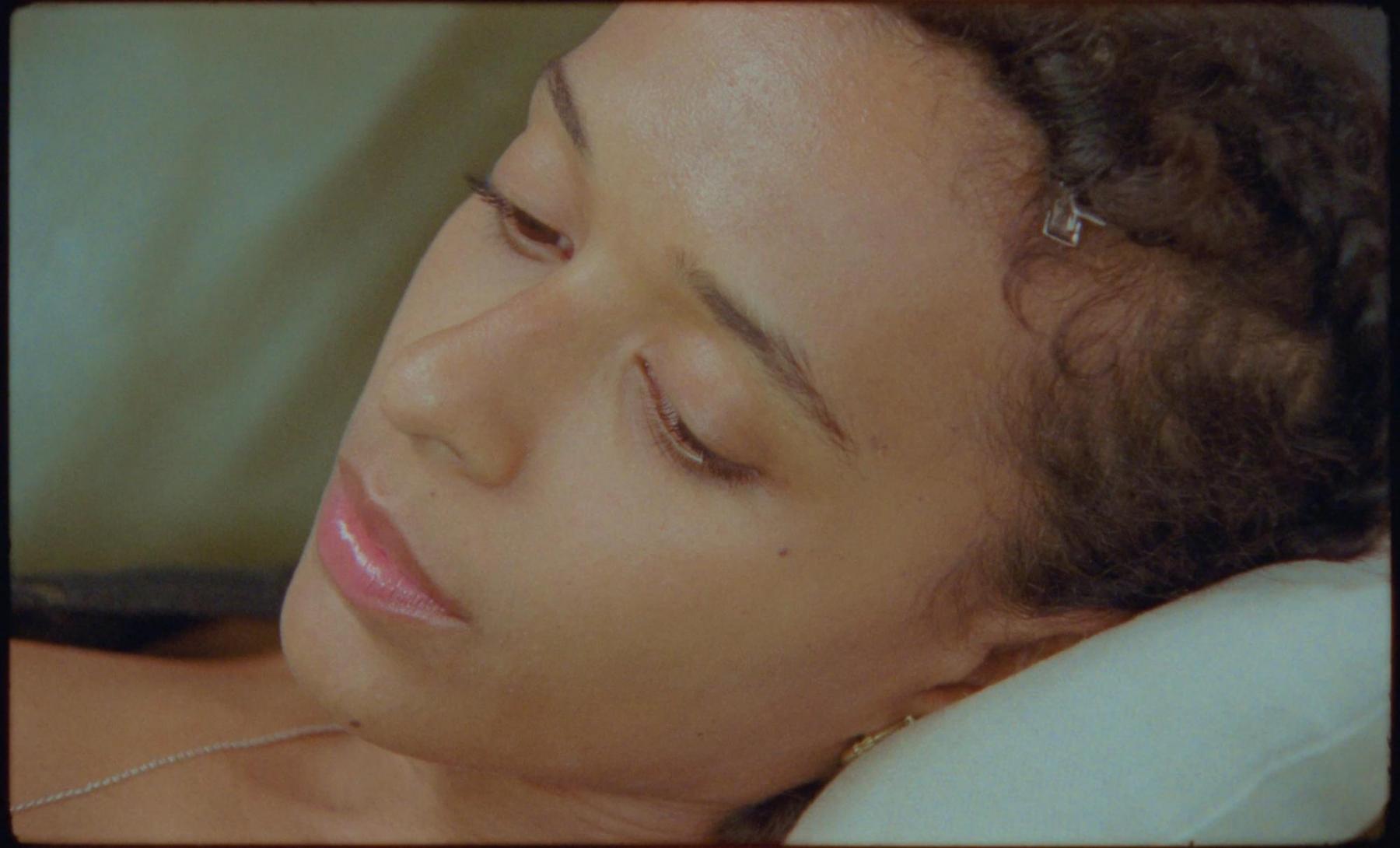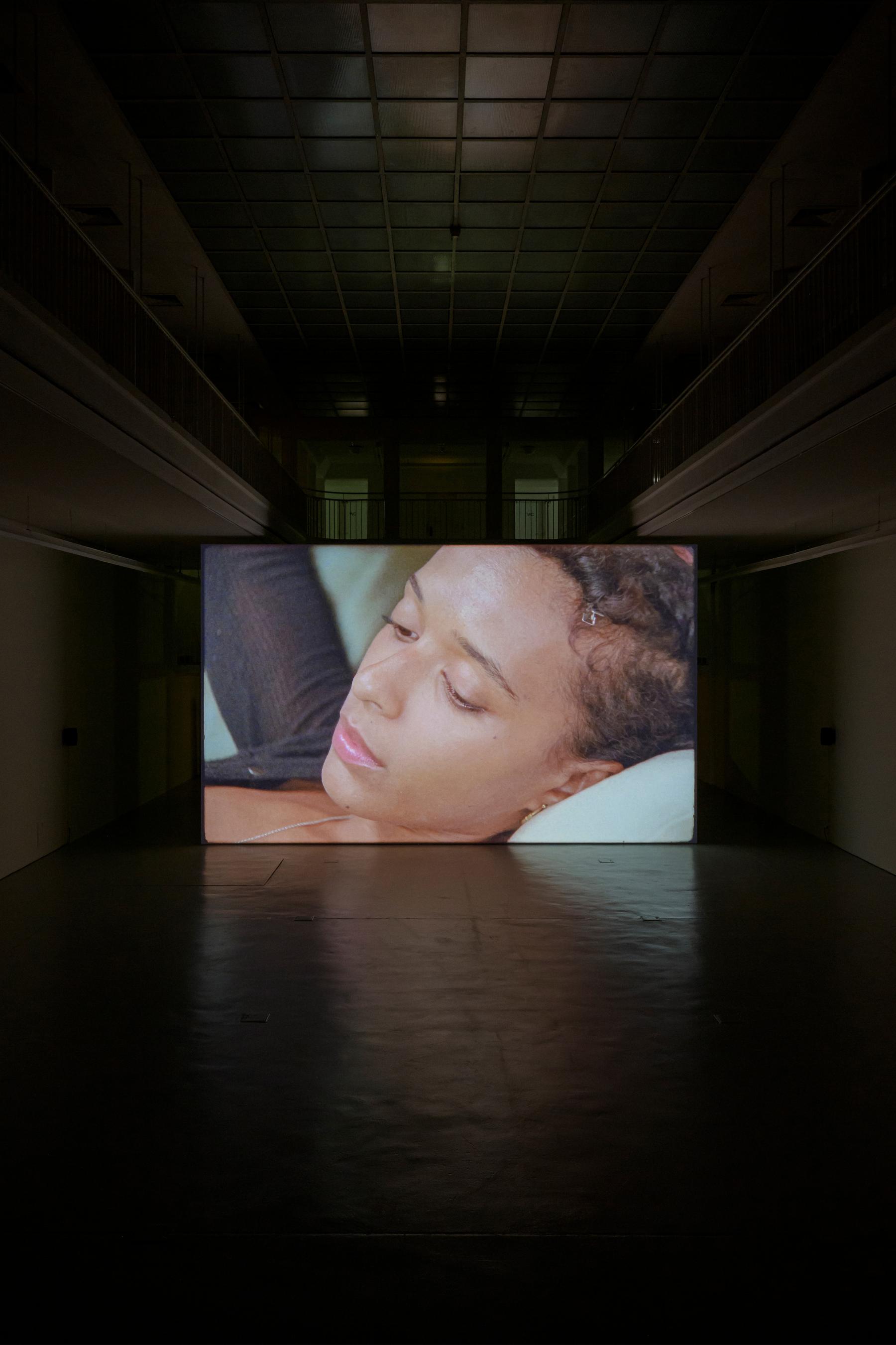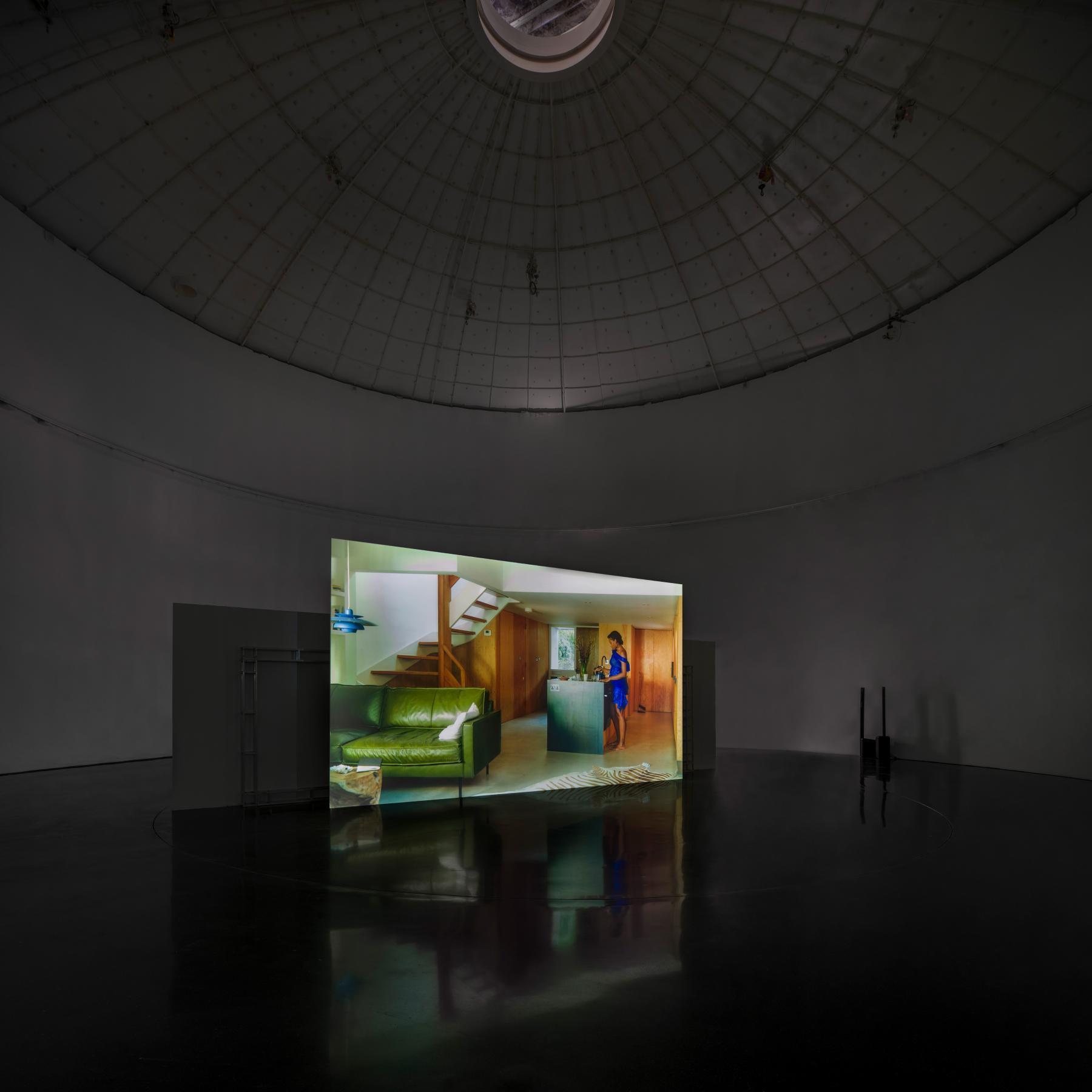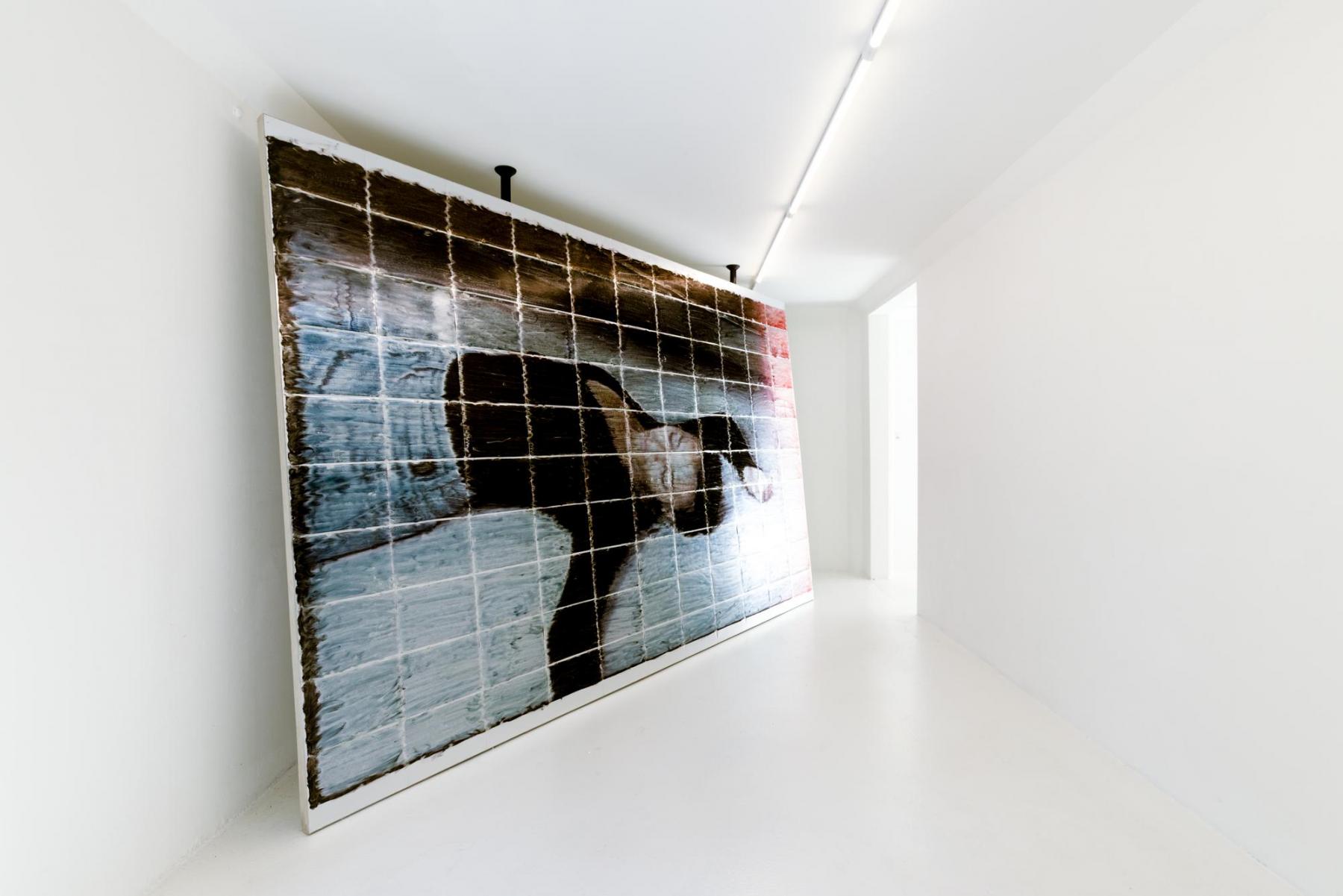
Close-up, 2024. Deborah-Joyce Holman. Film still. Courtesy of the artist.
Rarely is the camera used to protect. More often it serves to capture, expose, and surveil. Deborah-Joyce Holman’s Close-Up stands in defiance of this, offering an alternative to this use of the lens. Unburdened by distraction, the film is a quiet loop of carefully framed shots following actress Tia Bannon around an apartment. We focus solely on her face, shadowing the mundanity of her actions—filling a kettle, eating fruit, lying down—entranced by her preoccupation. There is no grand narrative, no sound beyond her movements, and yet, we are left wanting more. What is she doing? What happens next? The slow pacing and tight framing bear the weight of expectation. Surely, such close contact must satisfy our curiosity and bend to the whims of our desires. But even her absence—a two-minute window—is controlled. Waiting like expectant guests, we are left looking around. Presented with an opportunity to learn more about Bannon, her disappearance triggers the camera to shield once again, viewing her space through paced and lingering shots. These are the set terms for access. This deliberate refusal to accommodate or offer clarity is central to Holman’s practice. Close-Up refuses to placate, instead offering a tension and a kind of aliveness rooted in intimacy and resistance.
A multidisciplinary artist, Holman’s work is entrenched in art as a functional tool and explores Black, mixed-race, and queer experiences through their visual representation. Holman’s work explores what can be defined as the politics of pause: favoring resistance and prioritizing interiority and ambiguity. In Set, we are witness to the presence of Black queer figures from film and TV through their domiciliary spaces, despite their absence in frame. Care and attention frame this work, emphasizing the minutiae of detail in the homespace. We see this in lit and melting candles, white flowers still in bloom at a meal. The lack of presence of these characters is not an erasure, but a distinct mark of Holman’s intention and awareness of representational demand. The order of self-definition and explanation does not exist. Instead, Holman allows for a moment of privacy in a world of overexposure. Across film, painting, photography and installation, Holman uses intimacy to shield and protect against the spectacularization of the Black woman and the queer body.
Following the culmination of their latest exhibition at City SALTS, I spoke with Deborah-Joyce Holman on their relationship with the camera, and the role of refusal and interiority in their practice.
My practice comes from a place of internal urgency. I am uneasy with this world. Art is a space where I get to experiment, play, but also negotiate some terms of being and meeting the world [...] especially the parts I don’t fully understand or lack any other form of expression for.
In a 2023 interview, you mentioned your work is driven less by medium, and more by what it is you have to say. However, a constant across your various media is the intimacy of your work. Can you tell me more about intimacy’s role in your practice and how visual form helps you explore Black and Black queer identities?
I would turn this question around and say that I explore visual forms through my lens, which is Black, mixed-race, and queer. To me, it’s quite natural that this articulates itself in a curiosity to explore the tensions that arise from occupying a space structured by paradoxes and contradictions. I’m interested in this aspect more than storytelling—which is why I wouldn’t say that my work explores identity. Intimacy might be a mode of relating I intuitively seem to seek in my work. I’m glad you’re mentioning intimacy, although I wonder what you mean by it? Does it speak to a sense of reciprocity and aliveness?
If we speak of intimacy then—through reciprocity and aliveness—do you see this as embedded in the work itself or manifesting in the viewer’s experience of the work? Or, maybe even both?
Questions of reciprocity definitely shape how I think through the relationship between camera and the person in front of it. It is the relation between the two—and by extension, with the eventual viewer—that interests me particularly, and how this shapes the image that is created.
How have texts like The Witch’s Flight and The Sovereignty of Quiet shaped your approach to film and viewership?
Both are a part of a school of Black thought that emphasizes the inseparability of aesthetic and racial regimes, and the resulting difficulties for adequate modes of representation. This inseparability creates many seemingly impossible conditions: I’m working with images in a world in which the image relies on a violent racial hierarchy and a colonial ordering of the world. So I am particularly interested in whether there is something, anything, productive that can come out of sitting in the midst of these paradoxes and contradictions. Is there a different visual language, or at least a different mode of engagement that can grow out of crafting explicit tensions between formal and conceptual approaches? If that tension opens up a little crack, how would that be done and what would appear out of that crack? If it is given that the aesthetic regime and recognizable formal conventions are built on the continuous exploitation and othering of Blackness—if this impossible condition is inescapable—then, I’m interested in the edges of this framework and the subtle ways in which I can push against what the image might superficially propose to do. For example, I am interested in the conditions that shape the appearance of a person on screen; and staying with seemingly simple gestures of refusal and resistance to an otherwise extractive and reductive act.
Can you tell me about your background, did that influence your desire to be an artist?
My practice comes from a place of internal urgency. I am uneasy with this world. Art is a space where I get to experiment, play, but also negotiate some terms of being and meeting the world—as it is always relational—especially the parts I don’t fully understand or lack any other form of expression for.
Let’s talk about your 2025 exhibitions. In Close-Up, you expand on its original iteration, Close-Up / Quiet as it’s kept, and present what seems like more insight into who your subject [Tia] is. But, despite such close contact, there’s also a nothingness on view. In an increasingly surveilled world, I’m intrigued by your use of the camera to protect rather than expose.
I am interested in using the codes of portraiture and asking whether there is a way to engage them that avoids the camera becoming a tool for surveillance, and how layers can be built between the portrayed person, the camera, and the viewers in a gesture of protection. This oscillation between portraiture and anti-portraiture intrigues me—in part because I have noticed that it seems to make viewers interrogate their own position vis-a-vis the person on screen without requiring explicit prompting or addressing. This tension is the result of conceptual, narrative and formal barriers in the case of Close-Up—the ambiguity of the character, her deadpan expression, the lack of speech or narrative, the grain of the 16mm film as a constant reminder of a surface—and the entirely reconstructed sound that scores both works, the character’s minute reenactment of a scene in Close-Up/ Quiet as it’s kept, etc. I do and say all this because I am hoping that the line of access, in the way that surveillance demands, is—if not entirely denied—at least blurred. And I think that in a world where a binary legibility is materially exploitable, this might be an effective mode of refusal as a way to step outside of the logics of capital and in this context, expanding the possibilities of appearance that do not rely on extraction or legibility.

Close-up, 2024. Deborah-Joyce Holman. Installation view at Kunstverein Freiburg. Photo: Marc Doradzillo. Courtesy of Kunstverein Freiburg & the artist.

Close-up/ Quiet as it's kept, 2023. Deborah-Joyce Holman. Installation view at TANK Shanghai, 2024. Courtesy of TANK Shanghai & the artist.
.jpg)
Repose - Extended Play, 2025. Deborah-Joyce Holman. Installation view at City SALTS, Birsfelden. Photo: Nicolas Gysin. Courtesy of City SALTS & the artist

Repose I, 2025. Deborah-Joyce Holman. Installation view at City SALTS, Birsfelden. Photo: Nicolas Gysin. Courtesy of City SALTS & the artist
Tenderness and its malleability is a key element of your work. Set offers minutiae of detail. How do you balance the juxtaposition of such a large scale piece with the lived and quiet presence of interiority in your art?
I don’t think of my work as malleable. I think it is quite specific in its ambiguity. The pairing of the large scale and a sense of quietness create an emphasis on the absence of the spectacle, which I’m drawn to.
I’m surprised and intrigued by your answer, I want to unpack this a bit more. Where does your sense of ambiguity and interiority live in your work? Is it in the form itself, or the open-ended way this is communicated to the viewer?
Some of your questions point at what I would call ambiguity. To me, the fact that these questions arise—for example, about Tia’s appearance on screen—is precisely the point. The question is more interesting to me than any definitive answers could be. It’s an invitation to think about the conditions that shape the possibilities for Black appearance, reproduction, and representation.
You’re currently showing a solo exhibition at City SALTS, can you share more about Repose - Extended Play?
Repose - Extended Play is the third work that’s come out of an extended project with Tia Bannon, including the films Close-Up/Quiet as it’s kept and Close-Up. In contrast to the preceding two works, this one is not a moving image work. Instead, Repose features a single film still taken from an unused scene. This film still is repeated through the exhibition space in large-format three times, and each is made up of smaller prints on metallic paper with a matte shine to it. I have kept on coming back to this film still over the last year, unsure how to deal with it or what to do with it. Originally, it was meant to be a part of Close-Up, but for all I have said earlier in regards to the barriers and the play between access and refusal, this scene seemed to be too tender, too immediate. Then I realised that if I printed on this specific metallic paper, the ink doesn’t seep in, nor does it ever really dry. Even more, the image is barely visible at first, and only through manual intervention where I push the printer ink around on the paper, does the image become at once visible, unstable and disturbed. This, to me, opened a path to approach images I would otherwise not exhibit, as they feel too vulnerable. Through this method the image literally and figuratively remains completely unfixed—which is somewhat of a metaphor for what I want for any figure appearing in my work. A sense of movement as opposed to confinement, the possibility to slip away out of view. While these images are prints, and therefore still, through the smudging of the ink the image has a hazy quality, and through the ink being kept on top of the paper’s surface, it changes over time. I figure these prints combine some of the overarching themes and concerns recurring through my films and paintings in a way that I feel I haven’t managed to achieve before.
Your practice is often defined by the politics of representation and is layered through form and theme. Are there any new subject areas you’re curious about exploring or building on in the future?
I am thinking a lot about the role and register of refusal required of us in an increasingly violent, fascist world. What of that work is possible to do within the arts, or more specifically, within the spaces and institutions my work is shown in? And what parts of that work imperatively have to take place outside of that realm?
Tell me more about Brazil. This year especially, it seems a mecca with more and more Black people opting to spend time there. Are there specific experiences you’re hoping will shape your work during your time there?
Yes, that’s interesting. I will be going there for a couple months as part of a residency, where I’ll continue to think about Black global geographies and modernist architecture.